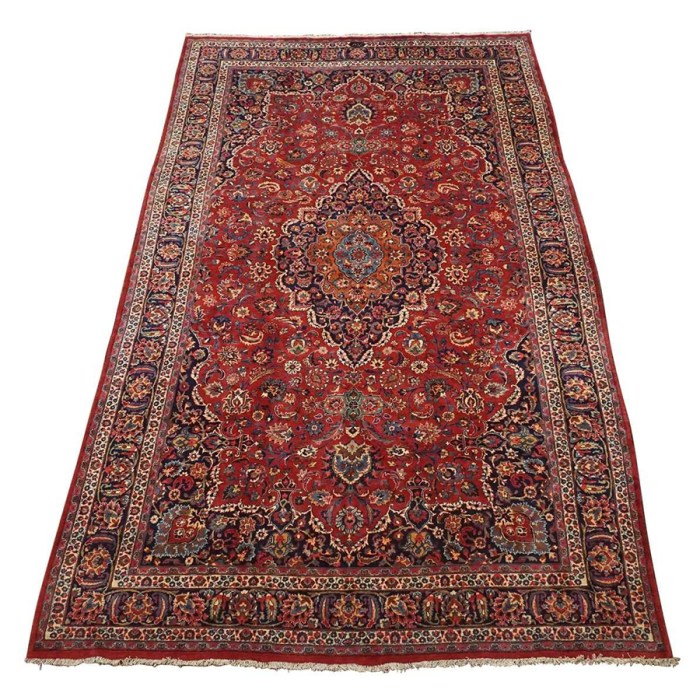Mashad rugs, renowned for their intricate designs and vibrant colors, are a testament to the rich cultural heritage of Persia. Their timeless beauty and exceptional craftsmanship have captivated collectors and decorators for centuries, making them a prized possession in any home.
From their humble origins to their modern interpretations, Mashad rugs have evolved while preserving their essence. Their story is one of tradition, artistry, and the enduring allure of Persian craftsmanship.
History and Origin of Mashad Rugs
Mashad rugs are a renowned type of Persian rug, originating from the city of Mashad in northeastern Iran. Their production dates back to the 16th century, during the Safavid dynasty, when Mashad emerged as a prominent center for carpet weaving.
Traditionally, Mashad rugs were crafted using hand-spun wool and natural dyes, giving them a distinctive and vibrant appearance. The designs often feature intricate floral motifs, geometric patterns, and scenes of everyday life, reflecting the cultural heritage of the region.
Production Methods
The production of Mashad rugs involves several intricate steps:
- Selecting and Spinning the Wool:The finest wool from local sheep is hand-spun to create the yarn for the rug.
- Dyeing the Wool:Natural dyes derived from plants, insects, and minerals are used to create the vibrant colors of Mashad rugs.
- Warping the Loom:The loom is set up with a series of parallel threads (the warp) that will form the foundation of the rug.
- Knotting the Pile:Using a special technique, skilled weavers tie individual knots of yarn around the warp threads, creating the pile (surface) of the rug.
- Trimming and Finishing:Once the rug is woven, it is trimmed and finished to give it its final appearance.
Design and Patterns
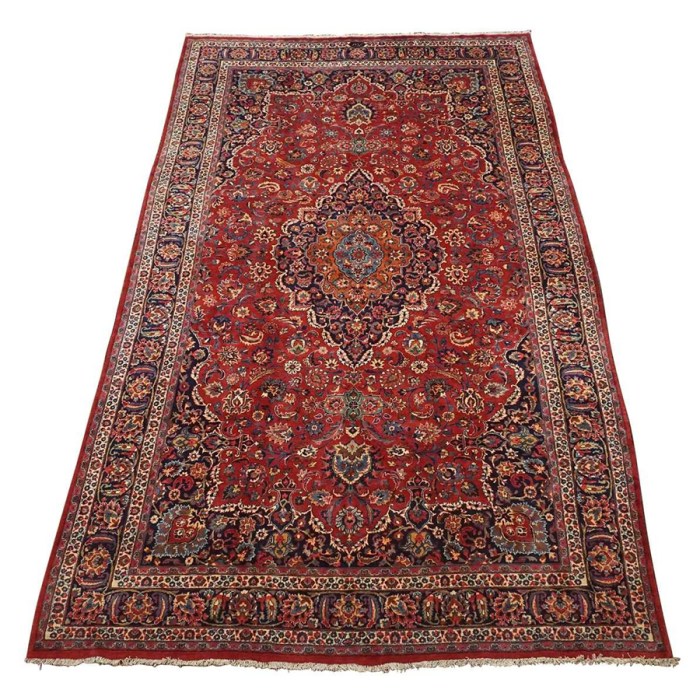
Mashad rugs are renowned for their intricate designs and captivating patterns, drawing inspiration from diverse cultural influences and rich symbolism. Each motif, shape, and color holds a significant meaning, reflecting the heritage and artistry of the region.
The medallion design is a hallmark of Mashad rugs, symbolizing the sun, a revered celestial body in Persian culture. Intricate floral patterns, such as the boteh (paisley) motif, represent fertility and growth, while geometric patterns showcase the precision and mathematical prowess of the weavers.
Floral Patterns
Floral patterns in Mashad rugs are a testament to the region’s lush gardens and vibrant plant life. Roses, carnations, and lilies are commonly depicted, symbolizing love, beauty, and purity. The boteh motif, resembling a paisley shape, is a stylized representation of a cypress tree, embodying strength and eternity.
Geometric Patterns
Geometric patterns in Mashad rugs demonstrate the weavers’ mastery of mathematical principles. Intricate latticework, stars, and octagons create a sense of order and harmony. These patterns often draw inspiration from Islamic architecture and geometric art, showcasing the influence of the region’s religious and cultural heritage.
Colors and Dyes
Mashad rugs are renowned for their vibrant colors, achieved through the use of natural dyes derived from plants, insects, and minerals. The rich hues and intricate patterns contribute significantly to the rugs’ aesthetic appeal and cultural significance.
The most common natural dyes used in Mashad rugs include:
- Madder root: Produces a range of red shades, from deep crimson to soft pink.
- Indigo: Extracted from the leaves of the indigo plant, creates a deep blue color.
- Pomegranate rind: Used to create a golden yellow hue.
- Walnut shells: Provide a rich brown color.
The dyes are carefully extracted and prepared using traditional techniques. The wool is then soaked in the dye baths for extended periods, allowing the colors to penetrate deeply. The result is a rug with vibrant and long-lasting hues.
Color Significance
Color plays a significant role in Mashad rug designs. Each color carries symbolic meaning and contributes to the overall aesthetic appeal of the rug.
- Red: Represents passion, courage, and vitality.
- Blue: Symbolizes peace, tranquility, and protection.
- Green: Associated with nature, growth, and prosperity.
- Yellow: Represents joy, happiness, and enlightenment.
The combination of these colors in intricate patterns creates visually stunning rugs that are both aesthetically pleasing and culturally significant.
Weaving Techniques
Mashad rugs are renowned for their exceptional craftsmanship and intricate weaving techniques. Skilled artisans employ various knotting methods to achieve the rug’s distinctive fine density and durability.
Knotting Methods
The Persian knot, also known as the asymmetrical knot, is the primary knot used in Mashad rugs. This technique involves wrapping the yarn around two adjacent warps, creating a small, tight knot. The knots are staggered and interlocked, resulting in a dense and durable weave.
- The density of the knots, measured in knots per square inch (KPSI), determines the rug’s quality and value. Mashad rugs typically have a KPSI of 100 to 200, indicating a high level of craftsmanship and detail.
- Another knotting method occasionally used in Mashad rugs is the Turkish knot, also known as the symmetrical knot. This technique involves wrapping the yarn around a single warp, creating a more open and airy weave.
Preservation of Traditional Techniques, Mashad rug
The preservation of traditional weaving techniques is crucial for maintaining the authenticity and quality of Mashad rugs. Skilled artisans pass down their knowledge and expertise through generations, ensuring that the intricate techniques are not lost.
The intricate designs of Mashad rugs evoke a sense of timeless elegance, much like the exquisite craftsmanship of Van Cleef & Arpels’ vintage Alhambra collection. Van Cleef & Arpels’ vintage Alhambra pieces showcase a harmonious blend of precious metals and vibrant gemstones, capturing the same allure and sophistication that characterizes the finest Mashad rugs.
- Master weavers play a vital role in guiding and training apprentices, transmitting the techniques and artistic traditions of Mashad rug weaving.
- By adhering to traditional methods, artisans preserve the cultural heritage associated with Mashad rugs and ensure their continued recognition as works of art.
Care and Maintenance
Mashad rugs, like all valuable textiles, require proper care and maintenance to preserve their beauty and longevity. Regular cleaning, proper storage, and timely repairs are essential to ensure these rugs remain in pristine condition for generations to come.
Cleaning
- Regular Vacuuming:Regularly vacuuming the rug using a soft brush attachment will remove dust, dirt, and loose debris that can accumulate over time. Vacuuming in the direction of the pile will prevent damage to the fibers.
- Spot Cleaning:For small spills or stains, blot immediately with a clean, damp cloth. Do not rub, as this can spread the stain. Use a mild detergent solution if necessary, and rinse thoroughly with water.
- Professional Cleaning:For deep cleaning or larger stains, it is recommended to seek professional cleaning services. Professional cleaners have specialized equipment and techniques to thoroughly clean the rug without damaging its delicate fibers.
Storage
- Avoid Direct Sunlight:Prolonged exposure to direct sunlight can fade the colors of the rug. Store it in a shaded area or use curtains to protect it from UV rays.
- Roll, Don’t Fold:When storing the rug, roll it up loosely with the pile facing inward. Avoid folding, as this can create creases that may be difficult to remove.
- Use Moth Repellents:To prevent moth damage, place moth repellents in the storage area. Natural repellents like cedar chips or lavender sachets are effective and safe.
Repairs
- Small Repairs:Minor tears or holes can be repaired using a needle and thread. Use a thread that matches the color of the rug and stitch carefully to avoid further damage.
- Professional Repairs:For larger repairs or damage, such as re-piling or re-weaving, it is advisable to consult a professional rug repair specialist. They have the skills and experience to restore the rug to its original condition.
- Regular Inspection:Regularly inspect the rug for any signs of wear or damage. Early detection and repair can prevent minor issues from becoming more severe.
Market Value and Appreciation: Mashad Rug
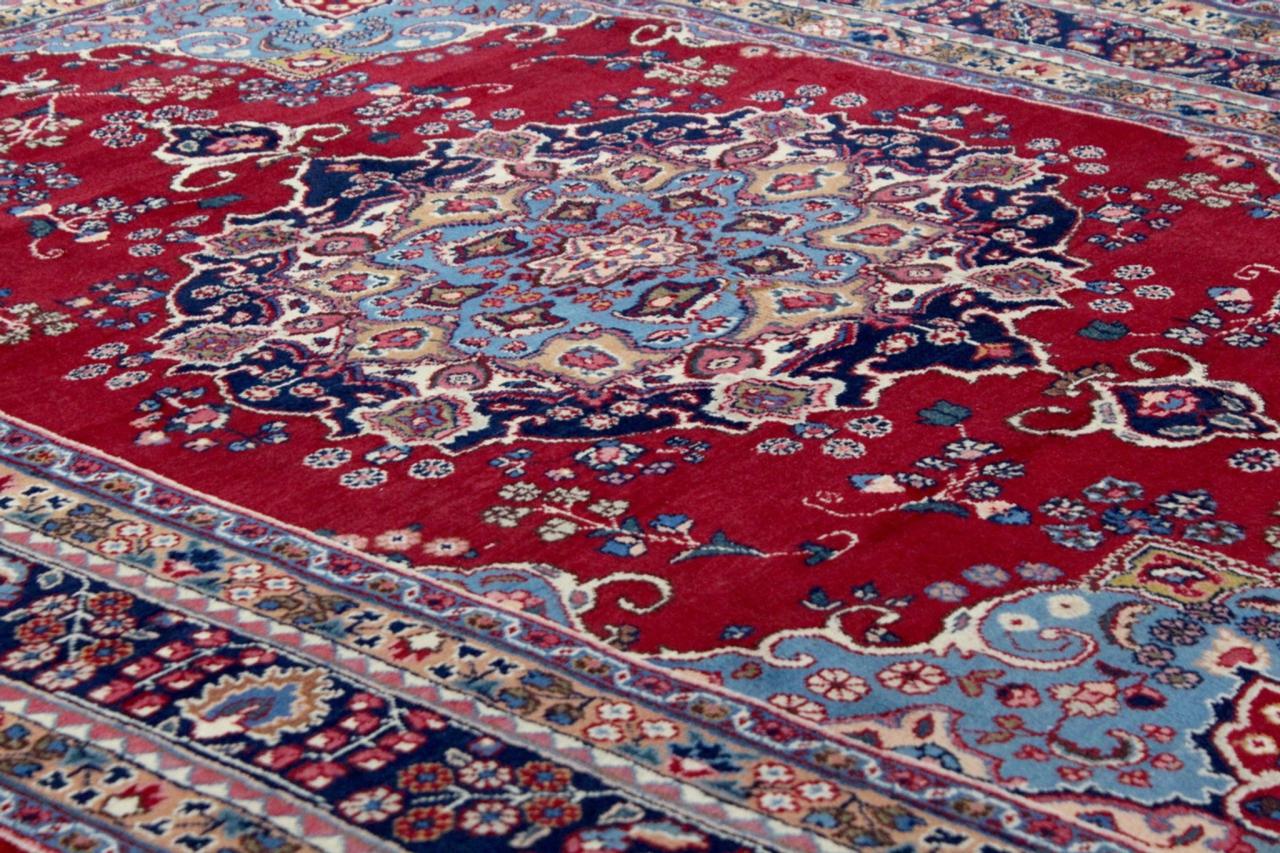
Mashad rugs are highly valued in the market due to their exquisite craftsmanship, intricate designs, and historical significance. Several factors contribute to their market value:
Age and Condition
- Older Mashad rugs are generally more valuable, as they represent a greater degree of historical significance and craftsmanship.
- The condition of the rug also affects its value, with well-preserved rugs commanding higher prices.
Design and Provenance
- Mashad rugs with intricate and unique designs are more highly prized, especially those featuring traditional Persian motifs and patterns.
- The provenance of the rug, including its history and ownership, can also enhance its value.
Appreciation in Value
Over time, Mashad rugs can appreciate significantly in value. Factors contributing to this appreciation include:
- Increasing demand for antique and collectible rugs
- Limited availability of high-quality Mashad rugs
- Preservation and restoration efforts that maintain the rug’s value
As a result, Mashad rugs can be considered a valuable investment, offering potential returns on appreciation over the long term.
Modern Interpretations
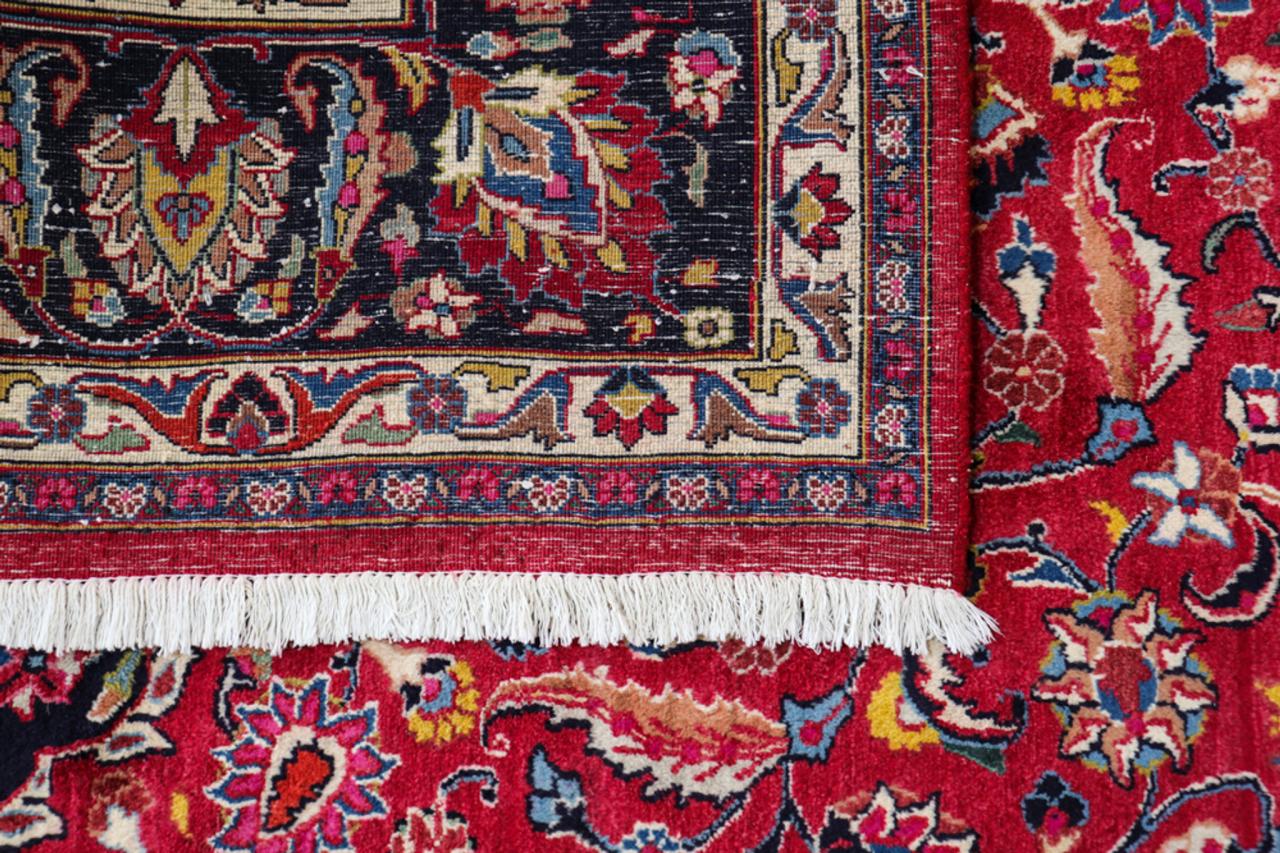
Modern interpretations of Mashad rugs blend traditional craftsmanship with contemporary aesthetics. These rugs preserve the essence of their heritage while incorporating innovative designs, color combinations, and weaving techniques.
Contemporary Designs
Modern Mashad rugs feature abstract and geometric patterns that deviate from traditional floral motifs. These designs often draw inspiration from modern art and architecture, creating rugs that are both visually striking and timeless.
Color Combinations
Contemporary interpretations explore unconventional color combinations that complement modern interiors. While traditional Mashad rugs typically feature warm earth tones, modern versions introduce vibrant hues and contrasting shades, adding a touch of sophistication and personality.
Innovative Weaving Techniques
Advances in weaving technology have enabled the creation of Mashad rugs with intricate textures and three-dimensional effects. Some modern rugs incorporate high-low pile techniques, creating a sense of depth and movement, while others utilize hand-carving to add sculptural elements.
Styling and Decor

Mashad rugs are versatile works of art that can seamlessly complement a wide range of interior design styles. Their intricate designs, luxurious textures, and vibrant colors make them ideal for adding warmth, texture, and visual interest to any space.
Traditional Interiors
In traditional interiors, Mashad rugs serve as a timeless and elegant foundation. Their intricate floral motifs, rich colors, and soft textures create a sense of warmth and sophistication. Pair them with antique furniture, heavy drapes, and rich fabrics for a cohesive and opulent look.
Contemporary Interiors
Mashad rugs can also add a touch of exotic charm to contemporary interiors. Their bold geometric patterns and vibrant colors can create a striking contrast against modern furnishings and clean lines. Experiment with placing them in unexpected areas, such as under a glass coffee table or as a wall hanging.
Eclectic Interiors
Mashad rugs thrive in eclectic interiors, where they can mix and match with other patterns, textures, and colors. Their ability to bridge different styles makes them perfect for creating a unique and personal space. Layer them with animal prints, ethnic textiles, and vintage pieces for a bohemian and eclectic look.
Environmental and Sustainability Considerations
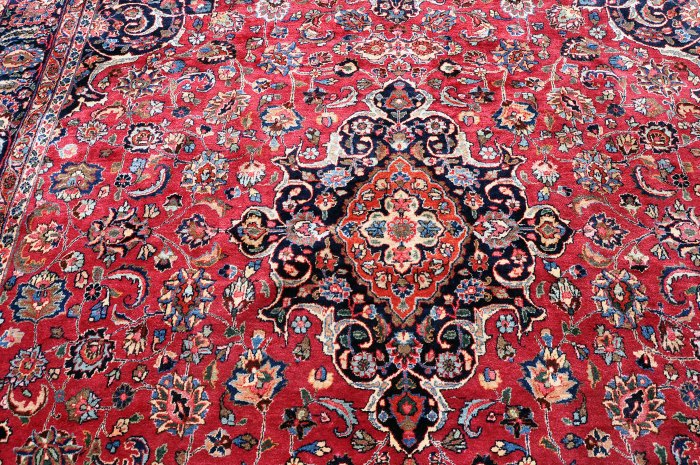
Mashad rug production has a significant impact on the environment due to the use of natural resources and the ethical treatment of animals. However, sustainable practices are being adopted by manufacturers to minimize their environmental footprint.
Use of Natural Resources
- Mashad rugs are made from wool, which is a renewable resource. However, sheep grazing can contribute to deforestation and soil erosion.
- The dyes used in Mashad rugs are often natural, but some synthetic dyes can be harmful to the environment.
Ethical Treatment of Animals
Sheep are the primary source of wool for Mashad rugs. It is important to ensure that the sheep are treated ethically, including providing adequate food, water, and shelter.
Sustainable Practices
- Some Mashad rug manufacturers are using sustainable wool production methods, such as rotational grazing and organic farming.
- Natural dyes are being used more frequently, reducing the environmental impact of synthetic dyes.
- Manufacturers are also exploring the use of recycled materials in their rugs.
Cultural Heritage and Preservation
Mashad rugs embody the rich cultural heritage of Iran, serving as tangible expressions of traditional craftsmanship and cultural identity. Their intricate designs and exquisite craftsmanship reflect the artistic heritage and technical skills passed down through generations of weavers.
Recognizing the cultural significance of Mashad rugs, concerted efforts are underway to preserve and promote the art of their weaving for future generations. These efforts include establishing weaving cooperatives, providing training programs for aspiring weavers, and promoting the appreciation of Mashad rugs through exhibitions and cultural events.
Preservation Initiatives
- Weaving Cooperatives: Establishing cooperatives allows weavers to share resources, access training, and market their products collectively, ensuring the sustainability of the craft.
- Training Programs: Workshops and training programs provide aspiring weavers with the skills and knowledge necessary to carry on the tradition of Mashad rug weaving.
- Exhibitions and Cultural Events: Showcasing Mashad rugs in exhibitions and cultural events raises awareness about their cultural significance and fosters appreciation for their beauty and craftsmanship.
Wrap-Up
Mashad rugs are more than just floor coverings; they are works of art that embody the spirit of Persia. Their intricate designs, vibrant colors, and exceptional craftsmanship make them a timeless treasure that will continue to be cherished for generations to come.
